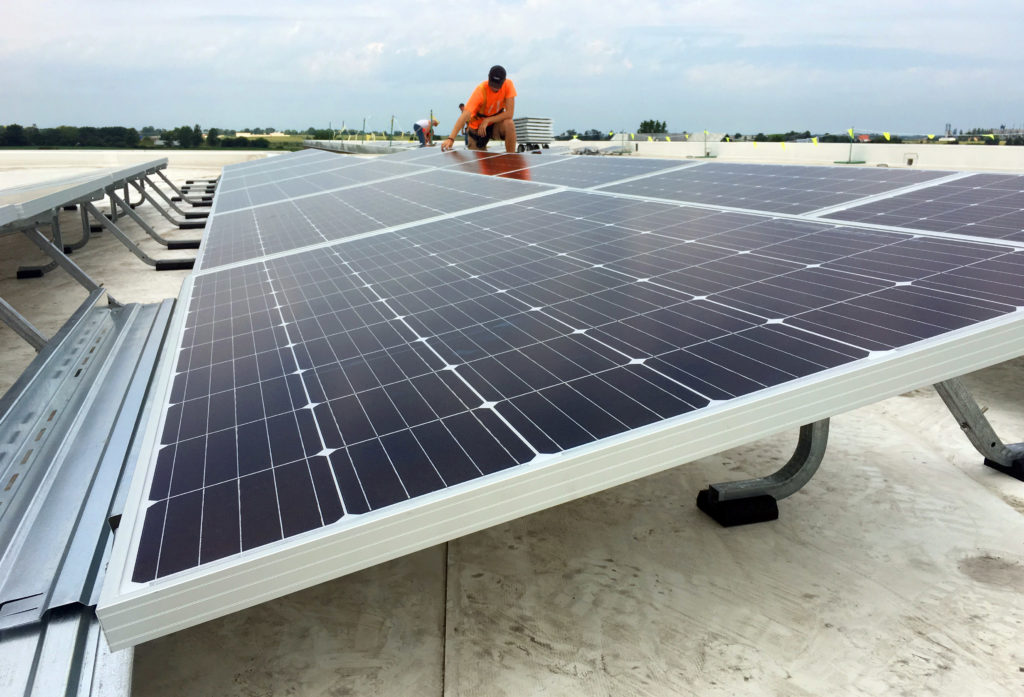DE Installs Solar Photovoltaic System – Targets Net-Zero
System To Provide 100% of Annual Energy Use Via 102.6 kW Rooftop Photovoltaic Array

Installers from Eagle Point Solar put new panels in place at Design Engineers HQ
Cedar Rapids, Iowa – July 27, 2016 – Working with installers from Eagle Point Solar and Alliant Energy, Design Engineers (DE) is in the process of installing a photovoltaic (PV) system as an active testing and demonstration lab for their clients.
This 6,500 square-foot, 360-module system runs without direct management, silently collecting sunlight and converting it to usable electricity every day. The 102.6 kW grid-tied electrical system supplies power back to Alliant, offsetting Design Engineers’ usage and billing. This symbiotic approach allows DE limitless access to power any time they need it while contributing to the grid’s daytime capacity and reducing the peak demand on central power plants.
“We designed the building to work with solar, to use it to our benefit, but we didn’t plan explicitly for this install,” admits Dwight Schumm, Managing Principal, “But we did plan for this potential, and today’s photovoltaics have become affordable, flexible, and durable enough for us to put it to the Iowa climate test.” In Cedar Rapids, average winter temperatures are typically below 20º F and summer temperatures average above 80º F. However, extreme temperatures above 110º F and well below -20º F are common in the Midwest—a range of more than 130º annually. Additionally, rooftop PV systems must withstand the highly variable wind. Storm systems bring 30 mph winds regularly with gusty conditions measuring 45 mph and above.

360 panels over 6,500 square feet will offset the production of CO2 to the scale of 122 ACRES of US forest.
The project team is optimistic about the installation in the face of such extreme conditions. According to Tim Lentz, project mechanical engineer, “Our low-slope roof is perfect for this installation. We’re using a ballasted installation, saving the roof membrane hundreds of screw holes.” Tim notes that the south-facing and relatively flat angle of the panels optimizes total annual production across seasons without additional tracking equipment to maintain. The low angle also minimizes wind loads and reduces visibility of the modules. “Sadly this system will be completely invisible to the public, but it’s accurate to what our clients would be looking for,” adds Tim.
“We benefit from having designed our own building’s systems to be as efficient as possible.” notes Amy Infelt, Managing Principal, “Our building’s energy use is almost exactly half the energy of a typical office building.”
The project is also a live demonstration of the environmental impacts of good design and available off-the-shelf technologies. “By offsetting our current usage entirely, DE is responsible for reducing emissions at the power plant by 212,652 pounds of carbon dioxide, 438 pounds of sulfur dioxide, and 240 pounds of nitrogen oxides.” said Joe Chappell, Design Engineers’ in-house energy guru. ” Add it up and that’s 142 tons of CO2 equivalent. We’re preventing the combustion of 68 tons of coal, annually, for at least 25 years.”
“The potential for PV in Iowa is incredible, and the economics are right to do it.” added Schumm. “We’re really excited to be doing this, and excited to share the results.”


